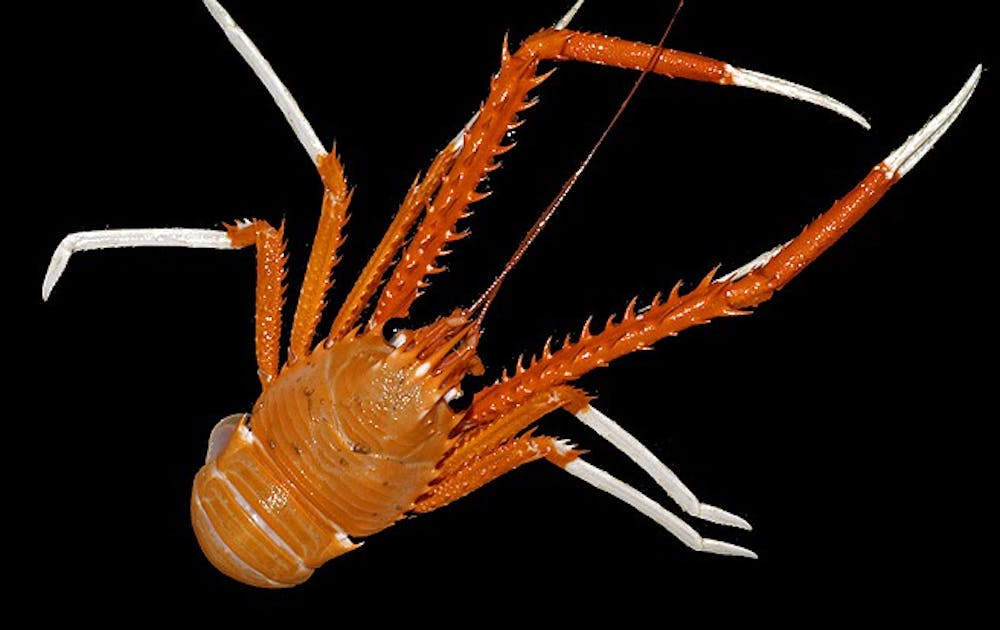Crabs that inhabit the darkness of the deep-sea ocean floor can detect ultraviolet light.
A team of researchers studied the visual sensitivities of crabs in the Bahamas and discovered that their eyes employ two distinct visual pigments to detect light in both the visual and ultraviolet spectrum. They hypothesized that this “two-channel system” allows the crabs to see in color to distinguish between the faintly green toxic corals in their habitat and the ultraviolet light emitted by their bioluminescent food, since very little sunlight and practically no ultraviolet radiation can reach the crab’s habitats.
“They have a second visual channel that’s most sensitive to ultraviolet and violet light, which is a real surprise because there’s almost no light of that type down there remaining from the sun,” said biology professor Sönke Johnsen, who authored the study, published today in the Journal of Experimental Biology. “Having a channel for that would seem completely pointless—you’re being sensitive to something that’s just not there.”
Because bioluminescent colors come in subtly different shades of blues and greens, possessing this type of visual channel allows the crabs to sort the colors out and discern between food and toxins, he added.
Although the researchers knew the crabs were capable of detecting ultraviolet light, they were unsure as to why they would need this ability, said Tamara Frank, a biologist at NOVA Southeastern University who worked on the study. Frank said the crabs were usually almost immobile but that over time, the researchers noticed them reaching for and apparently eating from the corals beneath them.
The long delays between their movements were explained by the crabs’ “long-exposure” vision—their eyes slowly assemble a coherent and detailed image from what little light is available in their surroundings, Frank said. As a result, the crabs had difficulty tracking motion or reacting quickly to visual stimuli, but moved very precisely once they had fully processed the environment. Because the crabs cannot eat the coral they live on, they had to get a precise image of their environment in order to extract the plankton that was stuck on the coral.
“They weren’t eating the [coral] structures they were sitting on, but they were periodically picking stuff off those structures,” Frank said. “[Sönke] thought that maybe they were using the two-pigment visual system to tell the difference.”
The researchers had to travel to the ocean floor to collect the crabs for study, rather than dragging a net, which would likely damage the environment and kill the crabs. Reaching their habitat was difficult, however, because the crabs live a half-mile below the ocean’s surface, where it is almost pitch black, Johnsen said. The researchers also had to take special measures to avoid blinding the crabs whose vision they were attempting to study. As a result, researchers could not use the bright navigational lights employed by most submersibles.
“We had to convince a submersible pilot to travel around with very dim red headlights,” Johnsen said. “It’s very difficult to see, but it works because then the animals aren’t blinded when you try to collect them.”
Johnsen is curious to see whether studies of the crabs’ unusual vision may be applicable in other fields of study, such as machine vision. The ability of the crabs to discriminate between different colors and shapes, even in near darkness, could be used to improve digital eyes.
“As a human, you can easily walk around under starlight and perform most normal activities,” Johnsen said. “Trying to do this with your average camera system is next to impossible.”
Although the researchers have not yet fully studied the crabs’ eyes, surprising innovations in optics have come from nature before. For example, lobster eyes have inspired the creation of new X-ray telescopes.
Because data was only collected from two areas in the Bahamas, however, the researchers plan on collecting more raw data before looking into possible innovations. Frank said she would like to study the optics of other animals in similar areas to see whether UV adaptation is more common than previously realized.
“We’d love to go down more and look at more locations, because this would be like driving behind two Wal-Marts in the United States and assuming that you understand what this country looks like,” Johnsen said. “We’ve only seen a few really small habitats like this.”
Get The Chronicle straight to your inbox
Signup for our weekly newsletter. Cancel at any time.

